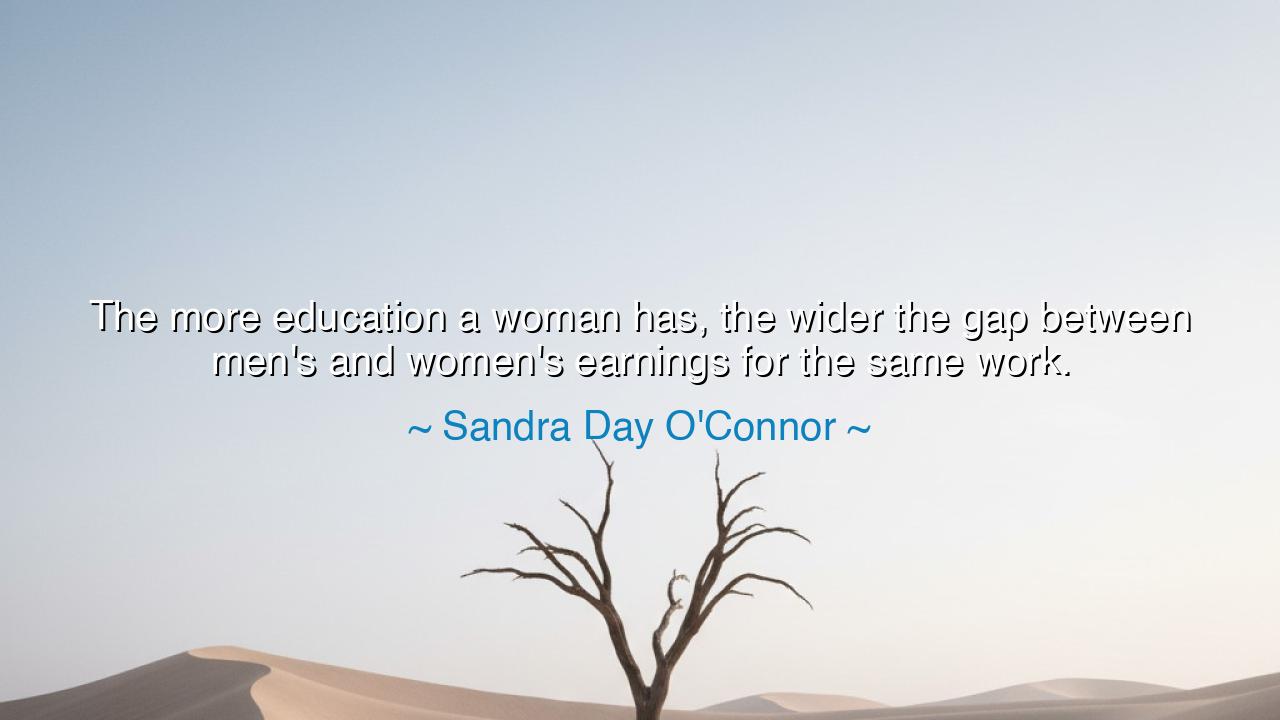
The more education a woman has, the wider the gap between men's
The more education a woman has, the wider the gap between men's and women's earnings for the same work.






“The more education a woman has, the wider the gap between men’s and women’s earnings for the same work.” – Sandra Day O’Connor
In these piercing and reflective words, Sandra Day O’Connor, the first woman to serve on the Supreme Court of the United States, shines a light upon a bitter paradox of the modern age: that education, which should be the great equalizer, too often exposes the deeper inequalities that still bind the lives of women. Her words are not merely an observation of economics—they are a lament for justice deferred, a reminder that progress in form does not always mean progress in substance. Beneath her calm, judicial tone lies a cry of awakening: that even as women ascend through learning and labor, the scales of reward remain uneven.
The meaning of this quote lies in its quiet indictment of systemic hypocrisy. O’Connor is not saying that education fails women; she is saying that society fails to honor what education should guarantee—equal dignity, equal recognition, equal pay. As women climb higher in achievement, the disparity grows sharper, because the higher rungs of the professional world are where discrimination becomes more subtle and entrenched. At the top of the ladder, merit alone no longer shields one from bias; it merely reveals it more starkly. O’Connor, a woman who herself had to fight for every step in a male-dominated profession, understood this truth from experience: education opens doors, but courage must still break barriers.
The origin of this wisdom arises from O’Connor’s own life—a journey marked by intellect, perseverance, and quiet defiance. Graduating near the top of her class at Stanford Law School in 1952, she found herself turned away by law firms that refused to hire a woman as an attorney. The very education that made her brilliant became, in the eyes of the world, a challenge to a system built for men. She accepted a position as a legal secretary, then built her way up through public service until she reached the nation’s highest court. In her own career, she lived the contradiction she described: that the more capable and qualified a woman became, the more resistance she met from those unwilling to share power.
History offers other mirrors of this truth. Consider Marie Curie, the first woman to win a Nobel Prize—and then to win it twice. Her discoveries in physics and chemistry transformed science, yet she faced exclusion from the French Academy of Sciences simply because she was a woman. Even as she illuminated the world with her intellect, she was paid less and honored less than men whose work was lesser than hers. Or consider Rosalind Franklin, whose research on DNA’s structure was foundational to modern genetics, yet whose recognition came only after her death. These are not mere stories of individual injustice; they are reflections of a pattern O’Connor named—a world where the brighter a woman shines, the deeper her shadow of inequality appears.
O’Connor’s quote also carries a moral tension. It forces us to confront an uncomfortable truth: that injustice evolves as knowledge grows. When women had no education, inequality was justified through ignorance. But when women proved themselves equal in intellect and skill, inequality persisted through excuse, prejudice, and institutional inertia. Thus, O’Connor’s insight is not only about economics—it is about the human heart’s resistance to equality, the pride and fear that guard old hierarchies even in an age of enlightenment. It is a warning that progress in opportunity must be matched by progress in conscience.
And yet, her words are not a call to despair, but to vigilance and courage. For O’Connor, the existence of this injustice was not a reason to retreat, but a summons to act. Her life stands as proof that the way forward lies not in bitterness, but in persistence. Through law, education, and example, she challenged the assumption that equality must be given rather than claimed. The power of her insight lies not in resignation, but in recognition: that to know the depth of injustice is the first step to uprooting it. As long as women continue to learn, to speak, and to lead, the balance can yet be restored.
The lesson of her words endures for all generations: that education alone is not liberation unless it is joined by justice. It is not enough to open schools and universities to women; we must open minds, laws, and hearts as well. In every workplace, every boardroom, every classroom, we must remember that talent has no gender, and equality is not a favor but a right. Let no woman’s learning become a burden, nor her excellence a cause for suspicion. Instead, let society match her effort with fairness, her courage with respect, her labor with equal reward.
Thus, as Sandra Day O’Connor teaches, the true measure of civilization is not how high its women can rise, but whether they are met as equals when they do. Her words, spoken in quiet truth, resound as a challenge to all who would inherit the future: do not mistake opportunity for equality, nor progress for completion. For until the educated woman stands not beside men in struggle, but beside them in recognition, the work of justice remains unfinished.






AAdministratorAdministrator
Welcome, honored guests. Please leave a comment, we will respond soon